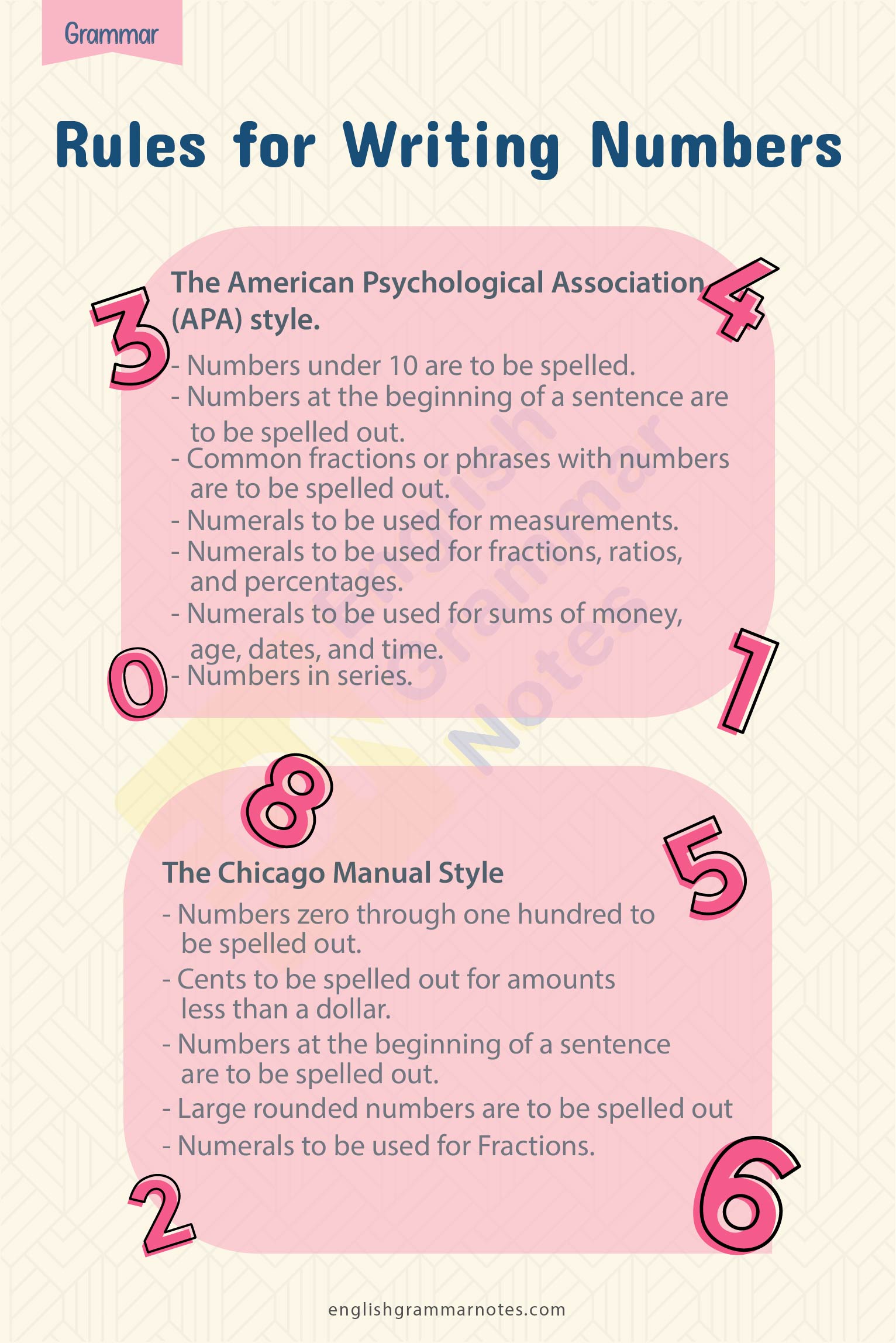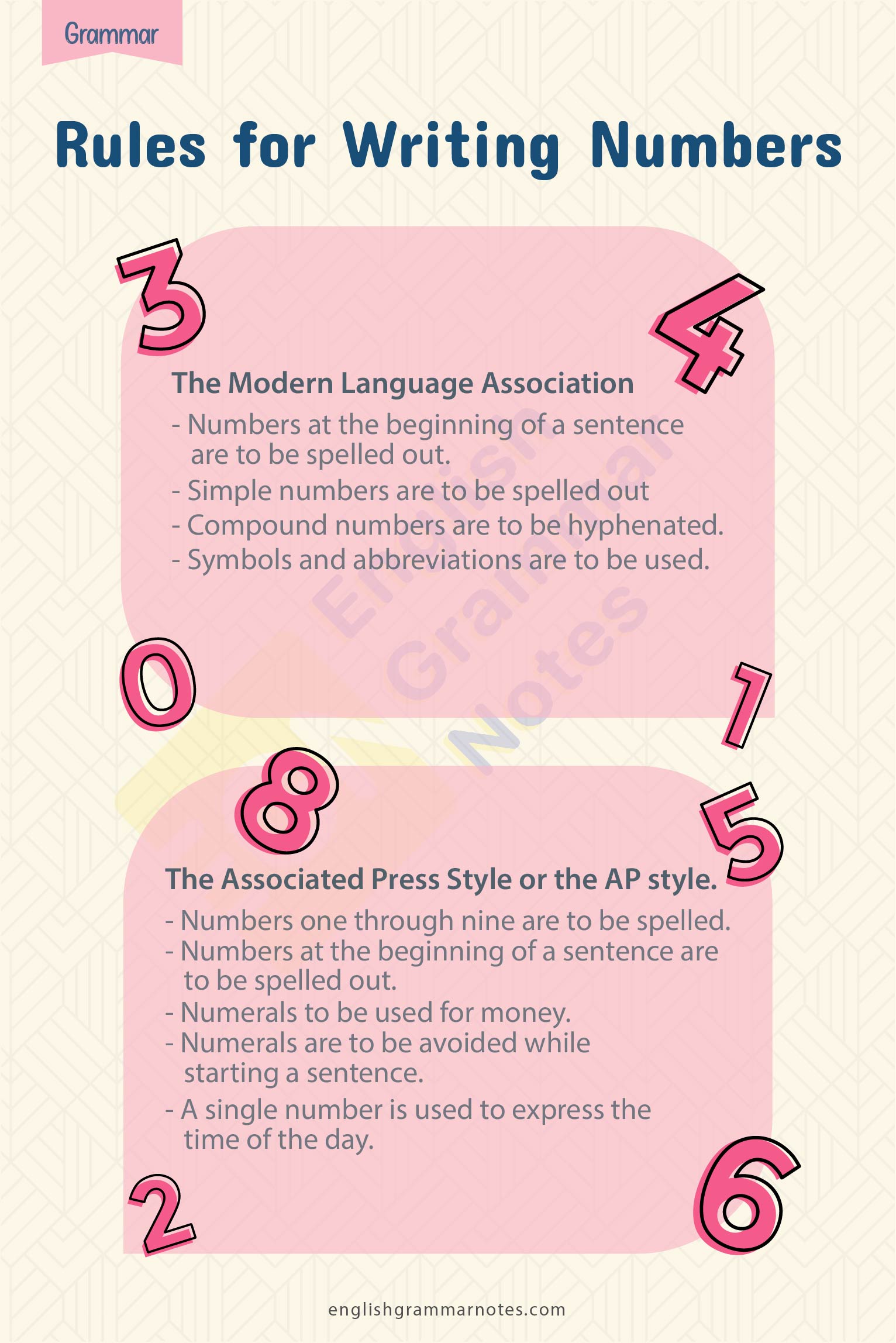When to Spell Out Numbers: Most of the time, when we write something, we end up encountering numbers. Therefore, it is essential to know when to spell out numbers and when to use numeric in place of numbers.
There are rules for writing numbers, just as there are for many other aspects of the English language. Specific numbers are written with letters, whereas others are exclusively written with numerals.
In this article, a set of rules based on different style guides for spelling out numbers have been discussed. This will help in understanding the rules of writing numbers and which rule suits which scenario the best, such as when to spell out numbers on a resume or using numbers in academic writing.
When to Spell Out Numbers in Different Styles
- 7 Rules for Writing Numbers in APA Style
- 5 Rules for Spelling Out Numbers in Chicago Style
- 4 Rules for Spelling Out Numbers in MLA Style
- 5 Rules for Spelling Out Numbers in AP Style
- Miscellaneous Set of Rules
7 Rules for Writing Numbers in APA Style
The American Psychological Association (APA) style manual is intended for scientific writing but can also be utilised in online editorials and content writing.
Numbers under 10 are to be spelled
Whenever following the APA style guide, you must spell out the numbers starting from 10 and above. Numbers below 10 are to be spelled.
Example: Arthur has two cousin brothers. Both are 12 years older than him.
Numbers at the beginning of a sentence are to be spelled out
Even if the number is less than 10, it should be spelled out rather than noted as a numerical at the start of a sentence.
Example: Nine of us have reached the hotel, but the other five are still on the way.
Common fractions or phrases with numbers are to be spelled out
When using phrases like “The Twelve Days of Christmas” or “one in fifteen people,” you spell them out rather than numerals.
Numerals to be used for measurements
When using a number preceding a measurement, you should use the numeral form.
Example: The ply is 5 feet long.
Numerals to be used for fractions, ratios, and percentages
Any number used for any statistical data like a fraction, percentage, or ratio, should be used in their numeral form.
Example: We have a 25% discount on all the showcased products.
Numerals to be used for sums of money, age, dates, and time
When you state something in a currency like dollar amounts or someone’s age, numerals should be used instead of spelling it out.
Example: Can you lend me 5 dollars?
We are hiring candidates above the age of 18 years.
Numbers in series
If you refer to a number in a series, you should use the numeral and capitalize the noun preceding it.
Example: I am sure he stays in Block 7.
5 Rules for Spelling Out Numbers in Chicago Style
The Chicago Manual Style has its own set of described rules for numbers when writing something. The following are the five rules set in the Chicago Style.
Numbers zero through one hundred to be spelled out
According to Chicago Style, numerals are to be represented for numbers above one hundred. However, whole numbers like five hundred and two thousand are to be spelled out. Numerals are to be used for non-whole numbers like 1,768 or 678.
Cents to be spelled out for amounts less than a dollar
Avoid using a dollar sign or a decimal point for sums less than a dollar, and instead, spell the type of change.
Example: Can you give me fifty cents from the $5 that I gave you in the morning?
Numbers at the beginning of a sentence are to be spelled out
Any number that starts a sentence is to be spelled out rather than noting the numeral.
Example: Six hundred and eighty candidates have registered for the webinar.
Large rounded numbers are to be spelled out
More than 100, followed by hundred, thousand, hundred thousand, or million, should be spelled out unless they refer to monetary sums.
Numerals to be used for Fractions
Unless they begin a sentence, use numerals for a fraction. If they are beginning a sentence, spell out the fractions.
Example: There are around 8 ½ carats of milk in the warehouse.
Three and one-half of the people are not willing to take part in the contest.

4 Rules for Spelling Out Numbers in MLA Style
The Modern Language Association has set a different set of rules for spelling out numbers in texts. Here are the four rules set by the Modern Language Association Style.
Numbers at the beginning of a sentence are to be spelled out
When a number is beginning a sentence, you must spell it out rather than using numerals.
Example: Twelve students have opted for the specialized course.
Simple numbers are to be spelled out
A number is spelt out if it can be written in one or two words. In all other cases, numerals should be used.
Example: I guess twenty-five buses will be enough for a headcount of 349 students.
Compound numbers are to be hyphenated
Compound numbers from twenty-one to twenty-nine are to be hyphenated.
Symbols and abbreviations are to be used
When writing under this style, you must pair the numerals with the appropriate symbols or abbreviations as and when necessary.
5 Rules for Spelling Out Numbers in AP Style
The Associated Press Style has its own set of rules for spelling out numbers based on different situations. Following are the set rules by the AP Style.
Numbers one through nine are to be spelled
For numbers ten or more significant, numerals are to be used. Ordinal numbers to follow the same set rule.
Example: Only two of us can take leave on the 15th.
Numbers at the beginning of a sentence are to be spelled out
When a number is beginning a sentence, you must spell it out rather than using numerals.
Example: Seventy people appear for the interview.
Numerals to be used for money
Except for cents or sums more than one million, all monetary amounts should be expressed numerically rather than spelling them out.
Example: A total of $13,000 has been raised as funds from the event.
Numerals are to be avoided while starting a sentence
When the sentence starts with a number, the number should be spelled out unless it is a year, in which case it can appear at the beginning of the sentence in numeral form.
Example: Seven passengers boarded the train.
1965 brought about a year of immense change.
A single number is used to express the time of the day
Instead of typing “11:00 p.m.,” the time should be written as an abbreviated numeral (“11 p.m.”).

Miscellaneous Set of Rules
Numerals to be used in Headings and Titles: When including a number in a heading or title, use a numeral rather than writing out a word. That is why listicle articles often have “Top 10” rather than “Top Ten.” Even if the number is the first word in the title, this requirement applies.
Numbers are used for days of the month
One should express dates numerically. There are a few unique guidelines for writing dates correctly. You can use a cardinal (5) or ordinal (5th) number when writing merely the day of the month. Both are true.
Numbers to be used for full dates
One can use numbers for the month, day, and year when writing out the whole date. Alternatively, you can spell out the month with numerals for the day and year.
Example: I shifted here on 13/02/2019.
Everyone is requested to submit their form by August 23, 2021.
To refer to decades
There are several alternatives when referring to a particular decade. You can use a single word, the entire date, or an abbreviated date.
Example: I love listening to ’80s jazz music.
They moved here in the nineties.
To write time
Use the digit to denote time when writing the time combined with a.m. to designate morning or p.m. to designate evening. Add the minutes after a colon to get the exact time (8:22 p.m.) When referring to an even hour, state the hour rather than including the fact that there are no minutes (use 2 a.m. instead of 2:00 a.m.). When using a.m. or p.m., do not utilize terms for the time (unless the first word in the sentence).
While writing an article or an assignment, make sure that you choose the writing style and then follow the same rules for that article. Though English is a language spelled with alphabets, numbers play an essential role, especially while writing or typing something down.